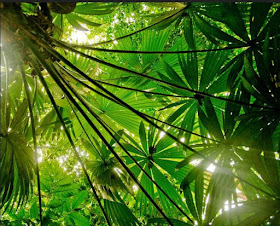.
10/26/2009, "Palms once grew in ice-free arctic,"
Reuters by Alister Doyle, via Australian Broadcasting
Corp.
"The scientists say the presence of palms in the Arctic suggests the modern climate system could yield big surprises. (Image above: photo from ABC.Au Science
website, stock.xchange)"
"Palms flourished in the Arctic during a brief
sweltering period about 50 million years ago, according to a study that
hints at gaps in our understanding of modern climate change.
The Arctic "would have looked very similar to the vegetation we now see in Florida," says Dr Appy Sluijs of Utrecht University [generic link] in the Netherlands who led the international study.
Evidence of palms has never been found so far north before.
The scientists, sampling sediments on a ridge on the seabed about 500
kilometres [310 miles] from the North Pole and up to 53.5 million years old, found
pollen from ancient palms as well as of conifers, oaks, pecans and other
trees.
"The presence of palm pollen implies that coldest month mean
temperatures over the Arctic land masses were no less than 8°C", the
scientists, based in the Netherlands and Germany, write in the journal Nature Geoscience. [generic link]
That contradicts computer model simulations, also used to predict
future temperatures, that suggest winter temperatures were below
freezing even in the unexplained hothouse period that lasted between
50,000 and 200,000 years ago during the Eocene epoch.
Sluijs
says that it was also striking that palms, which do not lose their
leaves in winter, grew in an area where the sun does not shine for about
five months. Experiments with modern palms indicate that they can
survive prolonged darkness.
The scientists say the presence of palms, it was not clear if they
were trees or plants, hinted that the modern climate system could yield
big surprises.
According to the UN Intergovernmental Panel on Climate Change, global temperatures are rising, due in part to human-made greenhouse gases, mainly from burning fossil fuels.
In 2007, Arctic ice shrank to its smallest size since satellite measurements began in the 1970s.
One possibility for the ancient spike in temperatures was an abrupt
rise in carbon dioxide levels, far beyond current concentrations.
That
might have been caused by volcanic eruptions, or a melt of frozen
methane trapped in the seabed.
"We cannot explain this with the current knowledge of the climate
system," says Sluijs. One possibility was that new types of clouds
formed in the Arctic as it warmed, acting as a blanket that trapped ever
more heat and accelerated warming.
"If the ocean was very warm it's possible that these clouds form at a
higher latitude than now," he says. Such effects caused by new cloud
formation could be an unexpected tripwire in accelerating modern climate
change."
...............

No comments:
Post a Comment